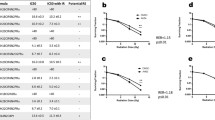Summary
The effects of a new generation ruthenium(III) complex, Na[trans-RuCl4(DMSO)Im], were compared with the effects of cisplatin in a model of the solid metastasising tumour MCa mammary carcinoma of CBA mice. By examining a number of intraperitoneal and intravenous administration schedules in mice either with spontaneous lung metastases or after artificial induction of tumour colonies, Na[trans-RuCl4(DMSO)Im] was found to behave differently from cisplatin. Unlike cisplatin, which is equally active on primary tumour growth and lung colonies, Na[trans-RuCl4(DMSO)Im] was markedly effective only on spontaneous metastases. The selectivity of Na[trans-RuCl4(DMSO)Im] on lung metastases was also marked on advanced metastases and accounted for a significant prolongation of host survival time, particularly in the experiments in which drug treatment was associated with surgical removal of a primary tumour. In combination with surgery, Na[trans-RuCl4(DMSO)Im] prevented metastasis formation and inhibited the growth of those already formed. This effect, although dependent on the dose used, was not associated with any residual effect on primary tumour cells after treatment discontinuation, whereas it tended to reduce the metastatic ability of the same tumour. This observation stresses the particular propensity of Na[trans-RuCl4(DMSO)Im] to binding metastatic cells rather than other tumour cell clones. On pBR 322 plasmid, Na[trans-RuCl4(DMSO)Im] was as effective as cisplatin in causing termination sites for replication, although it was only weakly active in generating interstrand crosslinking on calf thymus DNA. These data support the view that Na[trans-RuCl4(DMSO)Im] is the first compound capable of selective activity on metastatic tumours, and is therefore capable of showing a significant advantage for the postsurgical prognosis when associated with surgical ablation of primary tumours.
Similar content being viewed by others
References
Sava G, Pacor S, Mestroni G, et al. Na[trans-RuCl4 (DMSO)Im], a metal complex of ruthenium with anti-metastatic properties. Clin Exp Metastasis 1992; 10: 273–80
Sava G, Pacor S, Mestroni G, et al. Effects of the ruthenium(III) complexes [mer-RuCl3(DMSO)2Im]° and Na[trans-RuCl4 (DMSO)Im] on solid mouse tumors. Anticancer Drugs 1992; 3: 25–31
Sava G, Pacor S, Bregant F, et al. Mechanism of tumor inibition by the metal complex trans-RuCl2(dimethylsulphoxide)4. Pharmacology (Life Science Advances) 1990; 9: 79–84
Sava G, Pacor S, Bregant F, et al. Metal complexes of ruthenium: antineoplastic properties and perspectives. Anticancer Drugs 1990; 1: 99–108
Giraldi T, Sava G, Bertoli G, et al. Antitumor action of two rhodium and ruthenium complexes in comparison with cis-diamminedichloro-platinum(II). Cancer Res 1977; 37: 2662–6
Sava G, Zorzet S, Giraldi T, et al. Antineoplastic activity and toxicity of an organometallic complex of ruthenium(II) in comparison with cis-PDD in mice bearing solid malignant neoplasms. Euro J Cancer Clin Oncol 1984; 20: 841–7
Sava G, Pacor S, Zorzet S, et al. Antitumor properties of dimethylsulphoxideruthenium(II) complexes in the Lewis lung carcinoma system. Pharmacol Res 1989; 21: 617–28
Pacor S, Sava G, Ceschia V, et al. Antineoplastic effects of mer-trichlorobisdimethylsulphoxideaminorutheniumIII against murine tumors: comparison with cisplatin and with ImH[RuIm2Cl4]. Chem Biol Interact 1991; 78: 223–34
Keppler BK, Henn M, Juhl UM, et al. New ruthenium complexes for the treatment of cancer. In: Clarke MJ, editor. Progress in clinical biochemistry and medicine - ruthenium and other non-platinum metal complexes in cancer chemotherapy. Heidelberg: Springer-Verlag, 1989: 41–69
Talmadge JE. The selective nature of metastasis. Cancer Metastasis Rev 1983; 2: 25–40
Heppner GH, Miller BE. Tumor heterogeneity: biological implications and therapeutic consequences. Cancer Metastasis Rev 1983; 2: 5–24
Alessio E, Balducci G, Calligaris M, et al. Synthesis, molecular structure, and chemical behavior of hydrogen trans-bis(dimethylsulphoxide)tetra-chlororuthenate (III) and mertrichlorotris(dimethyl-sulphoxide)ruthenium(III): the first fully characterised chloride-dimethylsulphoxide-ruthenium(III) complexes. Inorganic Chemistry 1991; 30: 609–18
Keppler BK, Rupp W, Juhl UM, et al. Synthesis, molecular structure and tumor inhibiting properties of imidazolium trans-bis(imidazole)tetrachlororuthenate(III) and its methyl-substituted derivatives. Inorganic Chemistry 1987; 26: 4366–70
Poliak-Blazi M, Boranic M, Marzan B, et al. A transplantable aplastic mammary carcinoma of CBA mice. Veterinarski Archiv 1981; 51: 99–107
Guide for the Care and Use of Laboratory Animals. DHHS Publ. No (NIH)86-23. Bethesda, Md: NIH, 1985
Morgan AR, Pulleybank DE. Native and denatured DNA, cross-linked and palindromic DNA and circular covalently-closed DNA analyzed by a sensitive fluorometric procedure. Biochem Biophys Res Commun 1974; 61: 396–403
Brent TO. Suppression of cross-link formation in chloroethyl-nitrosourea-treated DNA by an activity in extracts of human leukemic lymphoblasts. Cancer Res 1984; 44: 1887–92
Coluccia M, Nassi A, Loseto F, et al. A trans platinum complex showing higher antitumor activity than the cis congeners. J Med Chem 1993; 36: 510–2
Gralla JD, Sasse-Dwight S, Poljak LG. Formation of blocking lesions at identical DNA sequences by the nitrosourea and platinum classes of anticancer drugs. Cancer Res 1987; 47: 5092–6
Gagliardi R, Sava G, Pacor S, et al. Antimetastatic action and toxicity on healthy tissues of Na[trans-RuCl4(DMSO)Im] in the mouse. Clin Exp Metastasis 1994; 12: 93–100
Sava G, et al. Data on file.
Author information
Authors and Affiliations
Rights and permissions
About this article
Cite this article
Sava, G., Pacor, S., Coluccia, M. et al. Response of MCa Mammary Carcinoma to Cisplatin and to Na[trans-RuCl4(DMSO)Im]. Drug Invest 8, 150–161 (1994). https://doi.org/10.1007/BF03259431
Published:
Issue Date:
DOI: https://doi.org/10.1007/BF03259431




